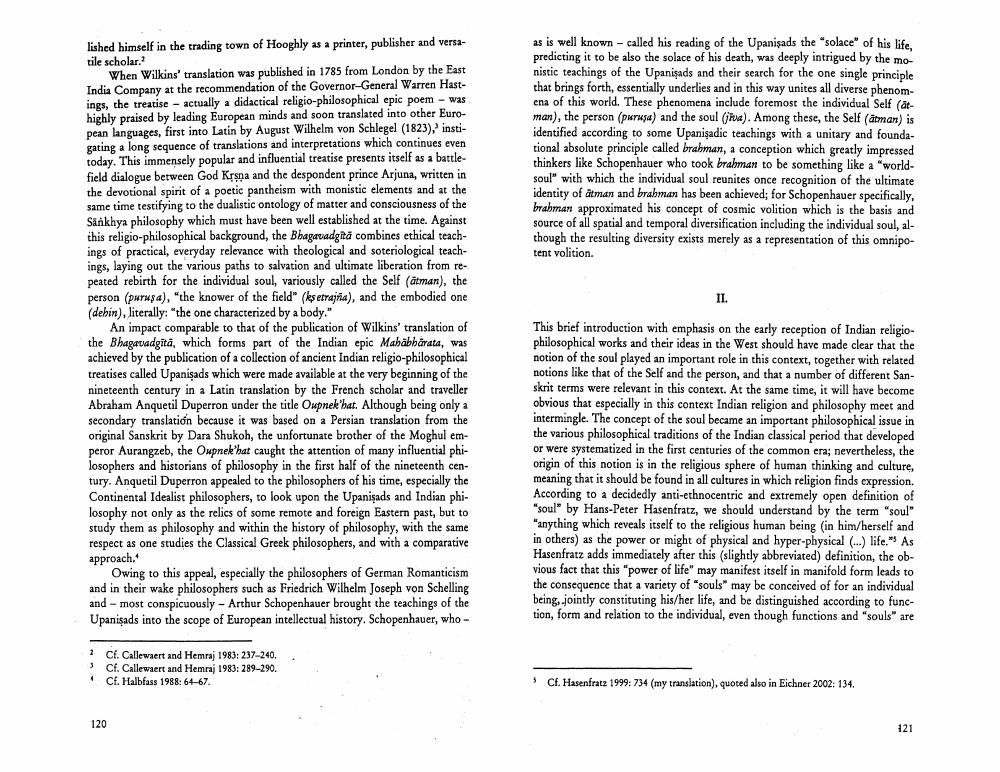Book Title: Soul Body And Person In Ancient India Author(s): Karin Preisendanz Publisher: Karin Preisendanz View full book textPage 2
________________ as is well known - called his reading of the Upanişads the "solace of his life. predicting it to be also the solace of his death, was deeply intrigued by the monistic teachings of the Upanişads and their search for the one single principle that brings forth, essentially underlies and in this way unites all diverse phenomena of this world. These phenomena include foremost the individual Self (atman), the person (purusa) and the soul (Hua). Among these, the Self (atman) is identified according to some Upanişadic teachings with a unitary and foundational absolute principle called brahman, a conception which greatly impressed thinkers like Schopenhauer who took brahman to be something like a "worldsoul" with which the individual soul reunites once recognition of the ultimate identity of atman and brahman has been achieved; for Schopenhauer specifically, brahman approximated his concept of cosmic volition which is the basis and source of all spatial and temporal diversification including the individual soul, although the resulting diversity exists merely as a representation of this omnipotent volition. IL. lished himself in the trading town of Hooghly as a printer, publisher and versatile scholar. When Wilkins' translation was published in 1785 from London by the East India Company at the recommendation of the Governor-General Warren Hastings, the treatise - actually a didactical religio-philosophical epic poem - Was highly praised by leading European minds and soon translated into other European languages, first into Latin by August Wilhelm von Schlegel (1823) instigating a long sequence of translations and interpretations which continues even today. This immensely popular and influential treatise presents itself as a battlefield dialogue between God Krsna and the despondent prince Arjuna, written in the devotional spirit of a poetic pantheism with monistic elements and at the same time testifying to the dualistic ontology of matter and consciousness of the Sankhya philosophy which must have been well established at the time. Against this religio-philosophical background, the Bhagavadgita combines ethical teachings of practical, everyday relevance with theological and soteriological teachings, laying out the various paths to salvation and ultimate liberation from repeated rebirth for the individual soul, variously called the Self (atman), the person (purusa), "the knower of the field" (les etrajña), and the embodied one (dehin), literally: "the one characterized by a body." An impact comparable to that of the publication of Wilkins' translation of the Bhagavadgita, which forms part of the Indian epic Mahabharata, was achieved by the publication of a collection of ancient Indian religio-philosophical treatises called Upanişads which were made available at the very beginning of the nineteenth century in a Latin translation by the French scholar and traveller Abraham Anquetil Duperron under the title Oupnek hat. Although being only a secondary translation because it was based on a Persian translation from the original Sanskrit by Dara Shukoh, the unfortunate brother of the Moghul emperor Aurangzeb, the Oupnek hat caught the attention of many influential philosophers and historians of philosophy in the first half of the nineteenth century. Anquetil Duperron appealed to the philosophers of his time, especially the Continental Idealist philosophers, to look upon the Upanişads and Indian philosophy not only as the relics of some remote and foreign Eastern past, but to study them as philosophy and within the history of philosophy, with the same respect as one studies the Classical Greek philosophers, and with a comparative approach. Owing to this appeal, especially the philosophers of German Romanticism and in their wake philosophers such as Friedrich Wilhelm Joseph von Schelling and - most conspicuously - Arthur Schopenhauer brought the teachings of the Upanişads into the scope of European intellectual history. Schopenhauer, who This brief introduction with emphasis on the early reception of Indian religiophilosophical works and their ideas in the West should have made clear that the notion of the soul played an important role in this context, together with related notions like that of the Self and the person, and that a number of different Sanskrit terms were relevant in this context. At the same time, it will have become obvious that especially in this context Indian religion and philosophy meet and intermingle. The concept of the soul became an important philosophical issue in the various philosophical traditions of the Indian classical period that developed or were systematized in the first centuries of the common cra; nevertheless, the origin of this notion is in the religious sphere of human thinking and culture, meaning that it should be found in all cultures in which religion finds expression. According to a decidedly anti-ethnocentric and extremely open definition of "soul" by Hans-Peter Hasenfratz, we should understand by the term "soul" "anything which reveals itself to the religious human being (in him/herself and in others) as the power or might of physical and hyper-physical (...) life." As Hasenfratz adds immediately after this slightly abbreviated) definition, the obvious fact that this "power of life" may manifest itself in manifold form leads to the consequence that a variety of souls" may be conceived of for an individual being jointly constituting his/her life, and be distinguished according to function, form and relation to the individual, even though functions and souls" are 1 3 Cf. Callewaert and Hemraj 1983: 237-240. Cf. Callewaert and Hemraj 1983: 289-290. Cf. Halbfass 1988: 64-67. Cf. Hasenfratz 1999: 734 (my translation), quoted also in Eichner 2002: 134 121Page Navigation
1 2 3 4 5 6 7 8 9 10 11 12 13 14 15 16 17 18 19 20 21 22 ... 29
